Sex Differences in Extensive Mitral Annular Calcification With Associated Mitral Valve Dysfunction
- PMID: 36881941
- PMCID: PMC10066827
- DOI: 10.1016/j.amjcard.2023.02.005
Sex Differences in Extensive Mitral Annular Calcification With Associated Mitral Valve Dysfunction
Abstract
Mitral annular calcification (MAC)-related mitral valve (MV) dysfunction is an increasingly recognized entity, which confers a high burden of morbidity and mortality. Although more common among women, there is a paucity of data regarding how the phenotype of MAC and the associated adverse clinical implications may differ between women and men. A total of 3,524 patients with extensive MAC and significant MAC-related MV dysfunction (i.e., transmitral gradient ≥3 mm Hg) were retrospectively analyzed from a large institutional database, with the goal of defining gender differences in clinical and echocardiographic characteristics and the prognostic importance of MAC-related MV dysfunction. We stratified patients into low- (3 to 5 mm Hg), moderate- (5 to 10 mm Hg), and high- (≥10 mm Hg) gradient groups and analyzed the gender differences in phenotype and outcome. The primary outcome was all-cause mortality, assessed using adjusted Cox regression models. Women represented the majority (67%) of subjects, were older (79.3 ± 10.4 vs 75.5 ± 10.9 years, p <0.001) and had a lower burden of cardiovascular co-morbidities than men. Women had higher transmitral gradients (5.7 ± 2.7 vs 5.3 ± 2.6 mm Hg, p <0.001), more concentric hypertrophy (49% vs 33%), and more mitral regurgitation. The median survival was 3.4 years (95% confidence interval 3.0 to 3.6) among women and 3.0 years (95% confidence interval 2.6 to 4.5) among men. The adjusted survival was worse among men, and the prognostic impact of the transmitral gradient did not differ overall by gender. In conclusion, we describe important gender differences among patients with MAC-related MV dysfunction and show worse adjusted survival among men; although, the adverse prognostic impact of the transmitral gradient was similar between men and women.
Copyright © 2023 Elsevier Inc. All rights reserved.
Conflict of interest statement
Disclosures The authors have no conflicts of interest to declare.
Figures



References
-
- Potpara TS, Vasiljevic ZM, Vujisic-Tesic BD, Marinkovic JM, Polovina MM, Stepanovic JM, Stankovic GR, Ostojic MC, Lip GYH. Mitral annular calcification predicts cardiovascular morbidity and mortality in middle-aged patients with atrial fibrillation: the Belgrade Atrial Fibrillation Study. Chest 2011;140:902–910. - PubMed
-
- Fox CS, Vasan RS, Parise H, Levy D, O’Donnell CJ, D’Agostino RB, Benjamin EJ. Mitral Annular Calcification Predicts Cardiovascular Morbidity and Mortality. Circulation 2003;107:1492–1496. - PubMed
Publication types
MeSH terms
Grants and funding
LinkOut - more resources
Full Text Sources
Medical

